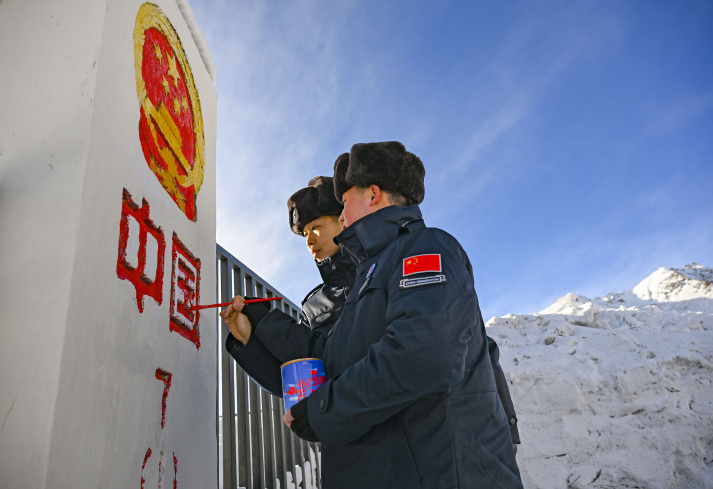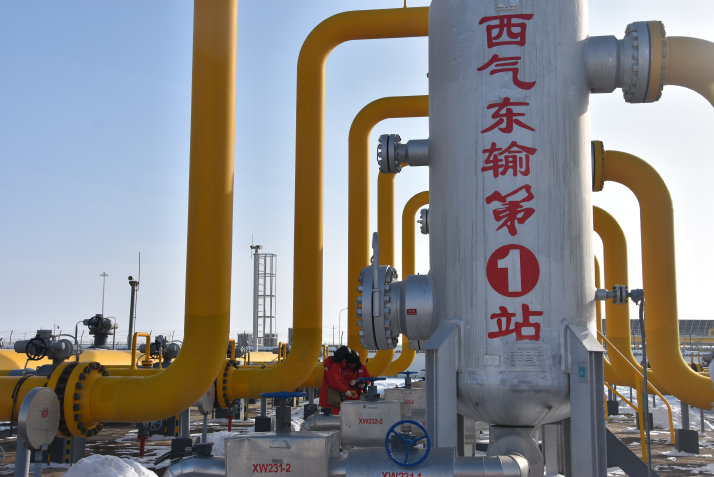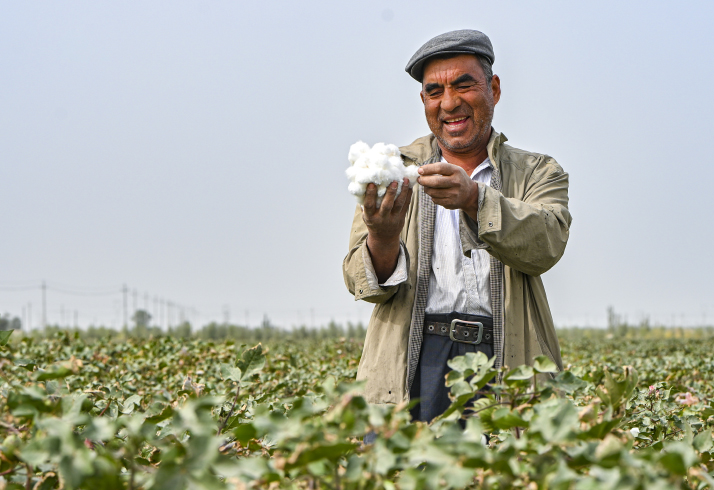| Xinjiang Today |
| A key role in national prosperity and security | |
|
|
 Police officers paint red Chinese characters "China" on a boundary marker at the Hongqilafu (Khunjerab) border checkpoint in Kashi (Kashgar) Prefecture on January 10 (XINHUA)
On the edge of the Tarim Basin, China's largest inland basin located in south Xinjiang, steel pipelines glint under the sun. The West-East Gas Pipeline, a game-changing project that delivers natural gas from west China to other parts of the country, saw its first station coming up in Luntai, a county in central part of the autonomous region. Today, at the station, compressors thrum as natural gas surges eastward through a network of pipes stretching more than 20,000 km. Across the plains in north and south Xinjiang, fields of winter wheat and cotton stretch to the horizon, their tidy rows the result of high-standard farmland characterized by well-leveled, contiguous plots with advanced irrigation, efficient water use and enhanced soil fertility. Further west, horse patrols and drones monitor the 6,700-km land border shared with eight countries. As China pursues high-quality development and deeper cooperation under the Belt and Road Initiative (BRI), Xinjiang's role has grown more strategic and more visible: a region whose pipelines, granaries and guard posts together underpin national security and prosperity. The China-proposed BRI boosts connectivity along and beyond the ancient Silk Road routes.  Workers inspect the facilities at the Luntai station of the West-East Gas Pipeline in the Tarim Oilfield on January 16 (XINHUA)
Directing energy eastward The West-East Gas Pipeline, which began commercial operation in 2004, has since grown into a vast four-line trunk system linking Xinjiang's gas fields with the nation's industrial heartlands. Its network connects to the China-Central Asia Gas Pipeline, a flagship BRI project at Huoerguosi (Khorgas or Horgos), a city in northwest Xinjiang straddling the border with Kazakhstan, then ties into the domestic backbone in the Yangtze River Delta, ultimately delivering fuel to 28 provincial-level regions and over 400 cities, nearly 500 million people in all. The Tarim Oilfield is a main natural gas source of the pipeline, and the Luntai station its nerve center, handling more than 85 percent of Tarim's metered throughput. Since it was commissioned, the station has never missed a day of supply. The scale of the pipeline is matched by its sophistication. High-angle laser methane sensors dot the oilfield to catch the faintest leak; autonomous robots keep up untiring patrols through desert heat and winter frost; and differential-pressure generators reclaim energy at the compression stage to produce "zero-carbon" electricity, with the surplus power flowing back into the grid. "The station currently supplies around 60 million cubic meters of natural gas per day, enough to meet the daily needs of an estimated 120 million households," station manager Liang Shijia said during a media visit in May. Production has risen in tandem. In 2024, Xinjiang advanced oil and gas exploration, development and production, reaching an output of nearly 66.64 million tons and leading the nation for the fourth consecutive year. New wells, gathering lines and processing hubs came online across the Tarim, Junggar and Turpan-Hami basins. The four lines of the west-east gas transmission project now drive fuel resources eastward, interlinking with other corridors to form "one national network" for dispatch. By May, the Luntai station had delivered over 370 billion cubic meters of natural gas, replacing 492 million tons of standard coal equivalent and cutting carbon dioxide emissions by 529 million tons. In effect, Xinjiang's gas has become a quiet bridge, one that links industrial continuity with cleaner growth. Electricity tells a parallel story. Xinjiang is rich in energy resources, including wind and solar power, and boasts excessive power generation capacity. It has transmitted locally generated electricity to other parts of the country through ultra-high-voltage (UHV) direct current lines. The UHV lines, an engineering pride, reduce electricity losses over long distances. The Changji—Guquan ±1100-kv UHV direct current power transmission project holds world records for voltage, capacity and distance; its peers now light homes and factories in 22 provincial-level regions.  A cotton farmer checks the crop in a field in Daxi Village, Bayingolin Mongolian Autonomous Prefecture, on September 19 (XINHUA)
The nation's food bowl If Xinjiang's gas and electricity keep factories humming and homes lighted, its food and fiber crops feed and clothe households and keep supply chains steady. Last year, Xinjiang's summer grain harvest came in at more than 7 million tons, holding steady from the previous year, while the autumn crop surged 14.9 percent to reach more than 16 million tons. Cotton told an even bigger story, with total output hitting 5.68 million tons, a historical record that accounted for more than 92 percent of the national total. Xinjiang's contribution to ensuring seed security is equally critical. Each year, more than 95 percent of Xinjiang's hybrid corn seed is shipped east to provinces like Heilongjiang and Shandong, underpinning planting seasons thousands of kilometers away. These harvests do not happen by chance. At the end of 2023, Xinjiang rolled out a three-year action plan to build integrated grain-and-oil industry clusters, mapping everything from breeding and planting to processing, logistics and branding. In 2024, the region allocated 21.43 billion yuan ($3 billion) to construct high-standard farmland, provide farming subsidies, support agricultural machinery purchases and promote seed cultivation. The funding also promoted industrial development, offering robust backing for agricultural production and easing farmers' concerns. Processing capabilities have made production resilient. Xinjiang today boasts more than 400 leading national- and provincial-level grain and oil enterprises. Labels like Xinjiang Flour and Xinjiang Sunflower Oil are gaining national recognition, while fresh investment is pouring into high-added-value processing, smart packaging and traceability systems. The strategy is clear: extending the chain to capture more value locally, and standardizing quality to compete nationally. The transformation is most tangible at the county level. In Keping in Aksu Prefecture, west-central Xinjiang, a cluster of over 200 smart greenhouses produce tomatoes, cucumbers and cherry tomatoes. Trial aquaculture to grow South American white shrimp and tilapia is also underway. Xinjiang's innovative farming uses high-quality alternatives for soilless cultivation such as substrates of coconut husk and rice chaff, while smart dashboards fine-tune fertigation and ventilation in real time. Guard and gateway Xinjiang shares a border with eight neighbors—Kazakhstan, Kyrgyzstan, Tajikistan, Afghanistan, Pakistan, Mongolia, Russia and India. Local residents are playing an important role in securing the border. In Tuoyun, a township in west Xinjiang, the family of Uruzhali Asha has patrolled the highlands for three generations. His father, Yisha Kuochal, did it on foot in an era without cold-weather gear. Repeated frostbite left him hard of hearing, yet he never abandoned his post. "To guard the frontier is responsibility of our family," Yisha Kuochal told the neighbors who asked why he still joined communal patrols. Uruzhali Asha learned the routes as a boy and today still repaints the faded numbers on boundary markers after clearing the snow. "The older generation guarded so the younger could build in peace," he said. "Our work is the first gate of that peace." Today, across border areas, a "smart frontier" system weaves together AI-enabled cameras, drones and integrated data platforms to manage risk across mountains, deserts and grasslands. In Changji, north-central Xinjiang, drone patrols in 2024 helped prevent more than 200 illegal crossings, cutting manpower costs by about 40 percent while expanding coverage eightfold compared with traditional truck patrols. In Bortala Mongolian Autonomous Prefecture, north Xinjiang, an integrated command platform links sensors with responders, enabling faster interception of suspicious activities. Security and development reinforce each other. From Huoerguosi, once a caravan stop on the ancient Silk Road, a China Railway Express freight train now departs roughly every 90 minutes, transporting Chinese exports to Central Asian and European markets, and vice versa. As a border officer sums it up, "Peaceful borders, prosperous markets. One sustains the other." (Print Edition Title: Electrifying Evolution) Comments to zhaowei@cicgamericas.com |
|
||||||||||||||||||||||||||||
|